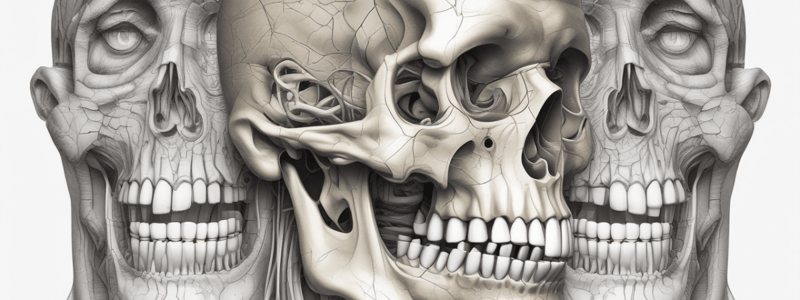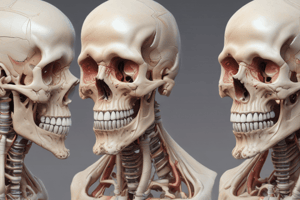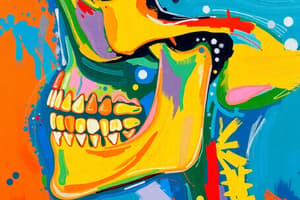Podcast
Questions and Answers
What is the primary movement occurring during lateral excursion of the mandible?
What is the primary movement occurring during lateral excursion of the mandible?
- Protrusion of the mandibular condyle and disc
- Elevation of the mandible
- Side to side translation of the condyle and disc within the fossa (correct)
- Rotational movement of the condyle and disc
What occurs during the early phase of depression of the mandible?
What occurs during the early phase of depression of the mandible?
- The disc moves in the opposite direction of the condyle
- The condyle rolls posteriorly within the concave inferior surface of the disc (correct)
- The condyle rolls anteriorly within the concave inferior surface of the disc
- The body of the mandible moves superiorly and posteriorly
What is the consequence of abnormal function in one TMJ?
What is the consequence of abnormal function in one TMJ?
- It has no effect on the other TMJ
- It leads to protrusion of the mandible
- It naturally interferes with the function of the other TMJ (correct)
- It causes the mandible to move only in a rotational manner
What occurs during retrusion of the mandible?
What occurs during retrusion of the mandible?
What is the maximum amount of mouth opening that occurs during depression of the mandible?
What is the maximum amount of mouth opening that occurs during depression of the mandible?
What is the movement of the mandible during the late phase of depression?
What is the movement of the mandible during the late phase of depression?
What guides the movement of the mandible during lateral excursion?
What guides the movement of the mandible during lateral excursion?
What is the action used to grind food during mastication?
What is the action used to grind food during mastication?
What is the result of bilateral action of the TMJs during movement of the mandible?
What is the result of bilateral action of the TMJs during movement of the mandible?
During which phase of depression does the body of the mandible move inferiorly and posteriorly?
During which phase of depression does the body of the mandible move inferiorly and posteriorly?
What happens to the condyle and disc during translation?
What happens to the condyle and disc during translation?
What is the result of bilateral contraction of the masseter muscle?
What is the result of bilateral contraction of the masseter muscle?
What is the effect of unilateral contraction of the temporalis muscle?
What is the effect of unilateral contraction of the temporalis muscle?
What is the result of bilateral contraction of the medial pterygoid muscle?
What is the result of bilateral contraction of the medial pterygoid muscle?
What is the effect of unilateral contraction of the lateral pterygoid muscle?
What is the effect of unilateral contraction of the lateral pterygoid muscle?
What is the main function of the secondary muscles of mastication?
What is the main function of the secondary muscles of mastication?
What is the special role of the superior head of the lateral pterygoid muscle?
What is the special role of the superior head of the lateral pterygoid muscle?
What happens to the axis of rotation at the end of opening?
What happens to the axis of rotation at the end of opening?
What is the result of bilateral contraction of the temporalis muscle?
What is the result of bilateral contraction of the temporalis muscle?
What is the effect of bilateral contraction of the lateral pterygoid muscle?
What is the effect of bilateral contraction of the lateral pterygoid muscle?
What is the primary function of the TMJ?
What is the primary function of the TMJ?
What type of joint is the TMJ?
What type of joint is the TMJ?
What is the function of the articular disk in the TMJ?
What is the function of the articular disk in the TMJ?
What is the main component of the passive stability of the TMJ?
What is the main component of the passive stability of the TMJ?
What is the movement of the mandible during protrusion?
What is the movement of the mandible during protrusion?
What is the function of the medial pole of the mandibular condyle?
What is the function of the medial pole of the mandibular condyle?
What is the characteristic of the articular disk of the TMJ?
What is the characteristic of the articular disk of the TMJ?
What is the function of the lateral temporomandibular ligament?
What is the function of the lateral temporomandibular ligament?
What is the movement of the mandible during depression?
What is the movement of the mandible during depression?
What is the characteristic of the retrodiscal tissue?
What is the characteristic of the retrodiscal tissue?
Flashcards
What is the TMJ?
What is the TMJ?
A bicondylar synovial joint connecting the lower jaw condyle to the temporal bone's mandibular fossa.
What are the main functions of the TMJ?
What are the main functions of the TMJ?
Mastication (chewing), talking, and swallowing, all performed bilaterally with tongue and teeth coordination.
What does the mastication process involve?
What does the mastication process involve?
The TMJ, tongue, and teeth working together to break down food.
What are the arthrologic features of the TMJ?
What are the arthrologic features of the TMJ?
Signup and view all the flashcards
What is the function of the articular disk?
What is the function of the articular disk?
Signup and view all the flashcards
What is the shape of the mandibular condyle?
What is the shape of the mandibular condyle?
Signup and view all the flashcards
What is the articular disc made of?
What is the articular disc made of?
Signup and view all the flashcards
What provides passive stability to the TMJ?
What provides passive stability to the TMJ?
Signup and view all the flashcards
What provides active stability to the TMJ?
What provides active stability to the TMJ?
Signup and view all the flashcards
What are the four main movements of the TMJ?
What are the four main movements of the TMJ?
Signup and view all the flashcards
What do protrusion and retrusion involve?
What do protrusion and retrusion involve?
Signup and view all the flashcards
What does lateral excursion involve?
What does lateral excursion involve?
Signup and view all the flashcards
What do depression and elevation involve?
What do depression and elevation involve?
Signup and view all the flashcards
What happens to the articular disk during TMJ Arthrokinematics?
What happens to the articular disk during TMJ Arthrokinematics?
Signup and view all the flashcards
What happens during protrusion and retrusion arthrokinematically?
What happens during protrusion and retrusion arthrokinematically?
Signup and view all the flashcards
What happens during lateral excursion arthrokinematically?
What happens during lateral excursion arthrokinematically?
Signup and view all the flashcards
What happens during depression and elevation arthrokinematically?
What happens during depression and elevation arthrokinematically?
Signup and view all the flashcards
What muscles are responsible for TMJ movement?
What muscles are responsible for TMJ movement?
Signup and view all the flashcards
How do the TMJ muscles function?
How do the TMJ muscles function?
Signup and view all the flashcards
Study Notes
TMJ Biomechanics
- The TMJ (Temporomandibular Joint) is a bicondylar synovial joint between the condyle in the lower jaw and the mandibular fossa of the temporal bone.
Function
- The TMJ's main functions include mastication, talking, and swallowing, working in bilateral action with the tongue and teeth.
Mastication Process
- The mastication process involves the TMJ, tongue, and teeth working together to break down food.
Arthrology of the TMJ
- The TMJ is a synovial joint that permits a wide range of rotation and translation, with an articular disk cushioning the forces related to mastication.
- The articular disk separates the joint into two synovial joint cavities: the inferior joint cavity and the superior joint cavity.
Anatomy of the TMJ
- The mandibular condyle has a convex shape with medial and lateral poles, covered by a thin layer of fibrocartilage.
- The articular disk is made of dense fibrocartilage, lacks blood supply and sensory innervation, and helps to generate greater congruency within the TMJ.
Stability of the TMJ
- Passive stability is provided by the fibrous capsule, articular disk, lateral temporomandibular ligament, and retrodiscal tissue.
- Active stability is provided by muscles.
Osteokinematics of the TMJ
- The TMJ has four main movements: protrusion-retrusion, lateral excursion, depression-elevation.
- Protrusion and retrusion involve anterior and posterior movements of the mandible without significant rotation.
- Lateral excursion involves side-to-side movement of the mandible, guided by the mandibular fossa and articular disk.
- Depression and elevation involve opening and closing the mouth, respectively.
TMJ Arthrokinematics
- The TMJ's arthrokinematics involve the movement of the mandible, with the articular disk translating in the direction of the condyle.
- Protrusion and retrusion involve anterior and posterior translation of the condyle and disk, respectively.
- Lateral excursion involves side-to-side translation of the condyle and disk.
- Depression and elevation involve rotation and translation of the condyle and disk.
Kinetics of the TMJ
- The muscles responsible for TMJ movement include the masseter, temporalis, medial pterygoid, and lateral pterygoid.
- Each muscle has a specific function in bilateral and unilateral contraction, affecting mandible movement and disc position.
Studying That Suits You
Use AI to generate personalized quizzes and flashcards to suit your learning preferences.




